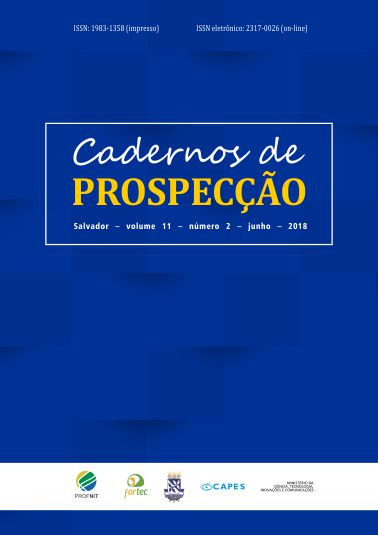Filamental Fungi as Corrosion Inhibitor: prospective study
DOI:
https://doi.org/10.9771/cp.v11i2.23226Keywords:
Corrosion Inhibitor , Fungi, Carbon Steel.Abstract
Corrosion of metals is a very common problem in the construction industry, generating damages in several structures and generating loss in the public and private sectors. Several methods and products responsible for inhibiting corrosion and protecting the metal have been developed to minimize this problem. In general, it is common to add heavy metals to steel to inhibiting corrosion, however conventional inhibitors are eventually expensive and harmful to the environment. Against this background, the creation of natural corrosion inhibitors such as fungal extracts, for example, may be a good way to solve this problem. In this work, several data were collected regarding the current literature and patent literature on the subject. The results were then analyzed and compared with a several parameters as countries that produce the most, the relationship between bibliographic and patent production, among others. It was observed in this research that both scientific production has been higher than technological production in the last ten years, however there has been a growing increase in the number of publications during this period. In this study, was observed that China is the largest publisher in this area, followed by the USA in both scientific and technological areas. These data show the importance of the topic and the innovative profile of this area of research.
Downloads
References
ABDEL-GABER A. M. et al. A natural extract as scale and corrosion inhibitor for steel surface in brine solution. Desalination, [S.l.], p. 337–342. 2011.
ABDEL-GABER A. M. et al. Inhibition of aluminium corrosion in alkaline solutions using natural compound. Materials Chemistry and Physics, [S.l.], v. 109, p. 297–305, 2008.
COELHO S. F. M. Corrosão de aço carbono em concretos microbiologicamente afetados. 2015. Tese (Doutorado) – Instituto de Química e Biotecnologia. Universidade Federal de Alagoas, Maceió, 2015
DRAKE, H. et al. Anaerobic consortia of fungi and surface reducing bacteria in deep granite fractures; Nature Communications, [S.l.], 2017.
ESPACENET. Patent seartch [Base de dados – Internet]. European Patent Office. 2017. Disponível em: . Acesso em: 20 jun. 2017.
GENTIL, V. Corrosão. 2. ed. Rio de Janeiro: LTC, 1982.
INSTITUTO NACIONAL DE PROPRIEDADE INTELECTUAL (INPI) [Base de dados –Internet]. 2017. Disponível em: . Acesso em: 9 jul. 2017.
KIP, N. et al. Methanogens predominate in natural corrosion protective layers on metal sheet piles; Scientif Reports, [S.l.], p. 7, 2017.
LENS [Base de dados – Internet]. 2017. Disponível em: . Acesso em: 9 out. 2017.
MORONA, M. T. Ensaios eletroquímicos e influência da interação plasma na resistência à corrosão do aço inoxidável ISO 5832-1. 2007. 94 f. Dissertação (Mestrado em Engenharia Mecânica e de Materiais) – Universidade Tecnológica Federal do Paraná, Curitiba, 2007.
PAUSTOVSKAYA, V. V. Some results of a research in the problem Inhibitors of metal corrosion.Toxicology and industrial hygiene. Protection of Metal, [S.l.], v. 36, p. 89–93, 1998.
RINCÓN, O. T.; DURACON COLLABORATION. Durability of concrete structures: DURACON, an iberoamerican project. Preliminary results. Building and Environment, [S.l.], v. 41, p. 952–962. 2006.
SCOPUS [Base de dados – Internet]. 2017. Disponível em: . Acesso em: 9 out. 2017.
SIELO [Base de dados – Internet]. 2017. Disponível em: . Acesso em: 9 jul. 2017.
TUSSOLINI, M. Estudo da aplicação de azóis na inibição da corrosão do aço inoxidável ABNT 430 em meio ácido. 2010. 89 f. Dissertação (Mestrado em Química Aplicada) – Universidade Estadual do Centro-Oeste, Guarapuava, 2010.
VAYSBURD, A. M.; EMMONS, P. H. Corrosion in concrete repair: concepts or misconcepts. Cement & Concrete Composites, [S.l.], v. 26, p. 255–263, 2004.
Downloads
Published
How to Cite
Issue
Section
License
Copyright (c) 2018 Cadernos de Prospecção

This work is licensed under a Creative Commons Attribution-NonCommercial 4.0 International License.
O autor declara que: - Todos os autores foram nomeados. - Está submetendo o manuscrito com o consentimento dos outros autores. - Caso o trabalho submetido tiver sido contratado por algum empregador, tem o consentimento do referido empregador. - Os autores estão cientes de que é condição de publicação que os manuscritos submetidos a esta revista não tenham sido publicados anteriormente e não sejam submetidos ou publicados simultaneamente em outro periódico sem prévia autorização do Conselho Editorial. - Os autores concordam que o seu artigo ou parte dele possa ser distribuído e/ou reproduzido por qualquer forma, incluindo traduções, desde que sejam citados de modo completo esta revista e os autores do manuscrito. - Revista Cadernos de Prospecção está licenciado com uma Licença Creative Commons Attribution 4.0. Esta licença permite que outros remixem, adaptem e criem a partir do seu trabalho para fins não comerciais, e embora os novos trabalhos tenham de lhe atribuir o devido crédito e não possam ser usados para fins comerciais, os usuários não têm de licenciar esses trabalhos derivados sob os mesmos termos.
Este obra está licenciado com uma Licença Creative Commons Atribuição 4.0 Internacional.





